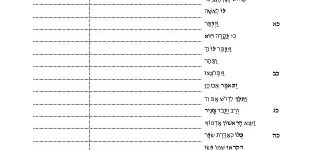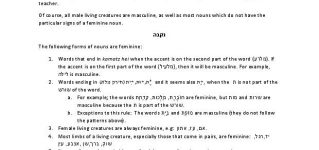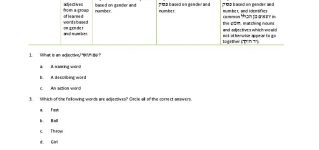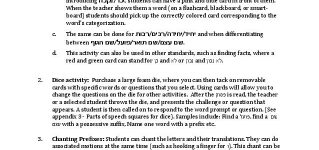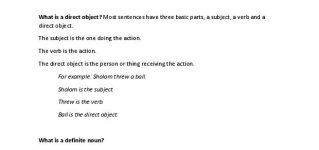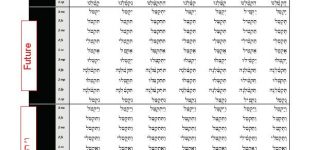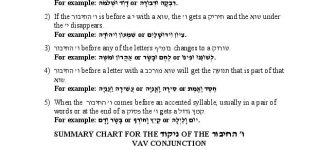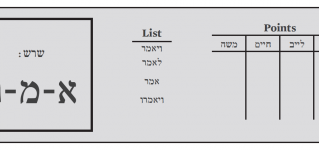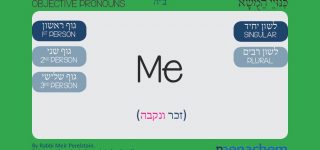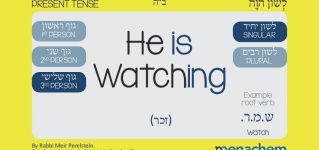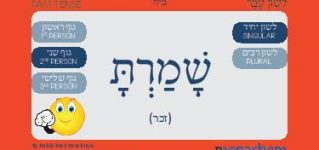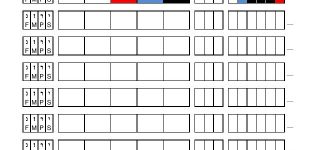Parts of Speech
The student will be able to identify and differentiate between parts of speech, and apply this knowledge to translate phrases in the חומש.
| Enduring Understandings |
|---|
| 1. As a G-dly language, לשון הקודש is both precise and concise, using grammar to incorporate information about a word in the word itself. |
| 2. Words serve different functions and are divided accordingly into parts of speech. |
| 3. In לשון הקודש, individual letters themselves, (as well as נקודות,) often have meanings and functions. (relevant to prefixes and suffixes). |
| Essential Questions |
|---|
| 1. How many words would be required in English to give the full meaning of this Hebrew word? |
| 2. What kind of word is this? |
| 3. What is the function of this letter? (relevant to prefixes and suffixes) |
Key Knowledge:
Nouns and verbs/adjectives are conjugated differently from one another in לשון הקדש. (Prefixes and suffixes change depending on whether the word is a noun or verb/adjective.)
Key Knowledge: (for 3.4 Nouns and Adjectives)
- Nouns are words which refer to people, places and things.
- Nouns in לשון הקודש have gender and number embedded in the way they are written.
- Adjectives are words that describe nouns. In Hebrew, an adjective is called a שם תואר.
- Adjectives in לשון הקודש have gender and number embedded in the way they are written, and must match the gender and number of the noun that it is describing.
3.04 Nouns and Adjectives
B. N/A
C. N/A
D. N/A
E. N/A
F. N/A
B. Distinguishes between זכר and נקבה nouns, in a group of learned words. (בקר, יום / לבנה, בהמה)
C. Distinguishes between singular and plural nouns (with –ות or –ים endings) in a group of learned words.
D. Identifies adjectives from a group of learned words, and give examples of adjectives in both לשון הקודש (from learned words) and English.
E. Matches nouns and adjectives from a group of learned words based on gender and number.
F. N/A
B. Distinguishes between זכר and נקבה nouns in the חומש, including common יוצאים מן הכלל in the חומש: words that appear to be זכר but are really נקבה, or appear to be נקבה but are really זכר, or words that can be either זכר or נקבה
C. Distinguishes between singular and plural nouns (with – ות or – ים endings) in the חומש, including words that end with רבים endings in לה”ק but are not plural in English (מים, פנים) and including common יוצאים מן הכלל in the חומש: words that are זכר but which receive – ות when in plural, (אבות, קרבנות) and words that are נקבה but receive – ים when in plural (שנה-שנים).
D. Identifies adjectives in a learned פסוק.
E. Matches nouns and adjectives in a learned פסוק based on gender and number.
F. Recognizes סמיכות – when one noun comes after the other, with the second noun describing or qualifying the first, and the word של is missing – when it has been pointed out by the teacher.[24]
B. Distinguishes between זכר and נקבה nouns in the חומש, including common יוצאים מן הכלל in the חומש: words that appear to be זכר but are really נקבה, or appear to be נקבה but are really זכר, or words that can be either זכר or נקבה
C. Distinguishes between singular and plural nouns (with – ות or – ים endings) in the חומש, including words that end with רבים endings in לה”ק but are not plural in English (מים, פנים) and including common יוצאים מן הכלל in the חומש: words that are זכר but which receive – ות when in plural, (אבות, קרבנות) and words that are נקבה but receive – ים when in plural (שנה-שנים).
D. Identifies adjectives in a learned פסוק.
E. Matches nouns and adjectives in a learned פסוק based on gender and number.
F. Recognizes סמיכות – when one noun comes after the other, with the second noun describing or qualifying the first, and the word של is missing – when it has been pointed out by the teacher.[24]
B. Distinguishes between זכר and נקבה nouns in the חומש, including common יוצאים מן הכלל in the חומש: words that appear to be זכר but are really נקבה, or appear to be נקבה but are really זכר, or words that can be either זכר or נקבה
C. Distinguishes between singular and plural nouns (with – ות or – ים endings) in the חומש, including words that end with רבים endings in לה”ק but are not plural in English (מים, פנים) and including common יוצאים מן הכלל in the חומש: words that are זכר but which receive – ות when in plural, (אבות, קרבנות) and words that are נקבה but receive – ים when in plural (שנה-שנים).
D. Identifies adjectives in an unlearned פסוק (based on the way it appears in the פסוק – its prefixes, suffixes, and form of the word – and on context[23]).
E. Matches nouns and adjectives in an unlearned פסוק based on gender and number.
F. Identifies סמיכות by context, and letter changes in the first word of the pair (when there is a –ים or קמץ ה ending).[25]
B. Distinguishes between זכר and נקבה nouns in the חומש, including common יוצאים מן הכלל in the חומש: words that appear to be זכר but are really נקבה, or appear to be נקבה but are really זכר, or words that can be either זכר or נקבה
C. Distinguishes between singular and plural nouns (with – ות or – ים endings) in the חומש, including words that end with רבים endings in לה”ק but are not plural in English (מים, פנים) and including common יוצאים מן הכלל in the חומש: words that are זכר but which receive – ות when in plural, (אבות, קרבנות) and words that are נקבה but receive – ים when in plural (שנה-שנים).
D. Identifies adjectives in an unlearned פסוק (based on the way it appears in the פסוק – its prefixes, suffixes, and form of the word – and on context[23]).
E. Matches nouns and adjectives in an unlearned פסוק based on gender and number.
F. Identifies סמיכות by context, and letter changes in the first word of the pair (when there is a –ים or קמץ ה ending).[25]
B. Distinguishes between זכר and נקבה nouns in the חומש, including common יוצאים מן הכלל in the חומש: words that appear to be זכר but are really [20]נקבה, or appear to be נקבה but are really [21]זכר, or words that can be either זכר or נקבהi[22].
C. Distinguishes between singular and plural nouns, including common יוצאים מן הכלל in the חומש: words that are זכר but which receive –ות when in plural, (אבות, קרבנות), and words that are נקבה but receive –ים when in plural (שנה-שנים).
D. Identifies adjectives in an unlearned פסוק (based on the way it appears in the פסוק – its prefixes, suffixes, and form of the word – and on context[23]).
E. Matches nouns and adjectives in an unlearned פסוק based on gender and number, and identifies common יוצאים מן הכלל in the חומש, matching nouns and adjectives which would not otherwise appear to go together (יד חזקה).
F. Identifies סמיכות by context, changes in the אותיות, changes in ניקודi[26], and טעמי המקרא.
B. Distinguishes between זכר and נקבה nouns in the חומש, including common יוצאים מן הכלל in the חומש: words that appear to be זכר but are really [20]נקבה, or appear to be נקבה but are really [21]זכר, or words that can be either זכר or נקבהi[22].
C. Distinguishes between singular and plural nouns, including common יוצאים מן הכלל in the חומש: words that are זכר but which receive –ות when in plural, (אבות, קרבנות), and words that are נקבה but receive –ים when in plural (שנה-שנים).
D. Identifies adjectives in an unlearned פסוק (based on the way it appears in the פסוק – its prefixes, suffixes, and form of the word – and on context[23]).
E. Matches nouns and adjectives in an unlearned פסוק based on gender and number, and identifies common יוצאים מן הכלל in the חומש, matching nouns and adjectives which would not otherwise appear to go together (יד חזקה).
F. Identifies סמיכות by context, changes in the אותיות, changes in ניקודi[26], and טעמי המקרא.
Grades 3-4: Identifies nouns in a learned פסוק.
Grades 5-6: Identifies nouns in an unlearned פסוק (based on the way it appears in the פסוק – its prefixes, suffixes, and form of the word).
Grades 7-8: Identifies nouns in an unlearned פסוק, including nouns that are related to and look like verbs or adjectives.[19]
Grade 2: Distinguishes between זכר and נקבה nouns, in a group of learned words. (בקר, יום / לבנה,
Grades 3-8: Distinguishes between זכר and נקבה nouns in the חומש, including common יוצאים מן הכלל in the חומש: words that appear to be זכר but are really [20]נקבה, or appear to be נקבה but are really [21]זכר, or words that can be either זכר or נקבהi[22]
Grade 2: Distinguishes between singular and plural nouns (with –ות or –ים endings) in a group of learned words.
Grades 3-8: Distinguishes between singular and plural nouns, including common יוצאים מן הכלל in the חומש: words that are זכר but which receive –ות when in plural, (אבות, קרבנות), and words that are נקבה but receive –ים when in plural (שנה-שנים).
Grade 2: Identifies adjectives from a group of learned words, and give examples of adjectives in both לשון הקודש (from learned words) and English.
Grades 3-4: Identifies adjectives in a learned פסוק.
Grades 5-8: Identifies adjectives in an unlearned פסוק (based on the way it appears in the פסוק – its prefixes, suffixes, and form of the word – and on context[23]).
Grade 2: Matches nouns and adjectives from a group of learned words based on gender and number.
Grades 3-4: Matches nouns and adjectives in a learned פסוק based on gender and number.
Grades 5-6: Matches nouns and adjectives in an unlearned פסוק based on gender and number.
Grades 7-8: Matches nouns and adjectives in an unlearned פסוק based on gender and number, and identifies common יוצאים מן הכלל in the חומש, matching nouns and adjectives which would not otherwise appear to go together (יד חזקה).
Grades 3-4: Recognizes סמיכות – when one noun comes after the other, with the second noun describing or qualifying the first, and the word של is missing – when it has been pointed out by the teacher.[24]
Grades 5-6: Identifies סמיכות by context, and letter changes in the first word of the pair (when there is a –ים or קמץ ה ending).[25]
Grades 7-8: Identifies סמיכות by context, changes in the אותיות, changes in ניקודi[26], and טעמי המקרא.
[19] Some examples: שופט, מפשט, מצוה, שופטים ושוטרים, שומר
[20] Body parts that come in pairs –e.g. יד/ידים, עינים/עין – and words relating to land and location – e.g. ארץ, מקום, עיר
[21] בית, לילה
[22] מחנה, שמש, רוח, אש See list in רש“י on בראשית, פרק ל“ב, פסוק ט‘, “המחנה האחת והכהו“.
[23] Context is essential with adjectives since they are often identical to nouns and verbs.
[24] E.g. בני ישרא–ל, תולדות נח, רוח א–לקים, פתח האהל, עבד אברהם, עבד עברי. The teacher can illustrate the changes in אותיות and/or ניקוד but this is not necessary until later grades.
[25] E.g. בני ישרא–ל, זעקת סדום
[26] E.g. ‘דְבַר ה instead of ‘דָבָר ה
Resources
3.05 Pronouns
Key Knowledge:
- A pronoun is a word that takes the place of a noun.
- Nouns can serve as either a subject or object: who or what is doing the action is the subject, and who or what is receiving the action is the object.
- Different kinds of pronouns replace nouns, depending on whether they are the subject or object. (For example, אני refers to a subject and is a subjective pronoun, and אותי refers to an object and is an objective pronoun, just like in English, “I” refers to a subject, and “me” refers to an object.)
- Pronouns also appear in other forms depending on how they are used in the sentence. For example, there are demonstrative pronouns to point something out (e.g. this, those – זה, זאת…), interrogative pronouns to ask questions (e.g. who, what, etc. – מי, מה), and prepositional pronouns to describe relationships in time and place (e.g. with, to, etc. – אלי, אתי, עמי, ממני).
- For every pronoun, we need to figure out who or what it is talking about. This is the pronoun’s referent (what the pronoun refers to). Pronouns match their referent nouns in gender and number.
- There is no such thing as “it” in לה”ק. Since all nouns, not only people, are either זכר or נקבה, the pronouns that replace them are always זכר or נקבה as well.
- In לה”ק, pronouns are often indicated by prefixes and suffixes attached to other words, instead of being written separately.
Note to Teachers: The first standard for each kind of pronoun is the ability to use that kind of pronoun in English. This standard should be taught as a fundamental, introductory unit to pronouns, in which the teacher points out to students how pronouns are used and their different varieties, and students have the opportunity to use them in a class discussion or exercise. The English pronouns themselves may not be new to first graders, but this הקדמה will make them more aware of the kinds of pronouns we use and the roles that they play.
B. N/A
C. Substitutes possessive nouns with pronouns, and identifies to what or to whom the pronouns refer, in English (my, mine, yours, his, hers, ours, theirs).
D. Substitutes objective nouns with pronouns, and identifies to what or to whom the pronouns refer, in English (me, him, her, us, them).
E. Uses demonstrative pronouns appropriately as a substitute for “a,” in English (this, that, these).
F. N/A
G. N/A
H. Uses interrogative pronouns – questions to which the answer is a noun/pronoun – in English, and responds to interrogative pronouns by providing the correct nouns. (e.g. who, to whom, whose, what, which…).
B. N/A
C. Substitutes possessive nouns with pronouns, and identifies to what or to whom the pronouns refer, in English (my, mine, yours, his, hers, ours, theirs).
D. Substitutes objective nouns with pronouns, and identifies to what or to whom the pronouns refer, in English (me, him, her, us, them).
E. Uses demonstrative pronouns appropriately as a substitute for “a,” in English (this, that, these).
F. N/A
G. Identifies the prefixes איתן and the pronouns to which they refer, in learned פסוקים.
H. Translates the interrogative pronouns in לה”ק, and responds correctly to questions that begin with them. (e.g.מי, מה, למי)
B. Distinguishes between first, second and third person pronouns (גוף ראשון, גוף שני, גוף שלישי…).
C. In learned פסוקים, identify possessive suffixes and state the pronouns and referents to which they refer.
D. States the objective pronouns in אותי,אותך) – לה”ק…) and can state the reference noun that they replace in learned פסוקים.
[30]E. States the demonstrative pronouns in לה”ק and translates them (from לה”ק to English and vice versa) (זה, זאת, אלה, אלו…).
F. N/A
G. Identifies the suffixes תהימון and the prefixes איתן and the pronouns to which they refer, in learned פסוקים.
H. Responds to questions beginning with the לה”ק interrogative pronouns, answering using the correct noun from the פסוקים . (e.g איזוהי מיהו,)
I. States the interrogative pronouns in לה”ק and translates them (from לה”ק to English and vice versa ,’מי, מה, איזו, איזה וכו)
B. Distinguishes between first, second and third person pronouns (גוף ראשון, גוף שני, גוף שלישי…).
C. In learned פסוקים, identify possessive suffixes and state the pronouns and referents to which they refer.
D. Identifies objective pronouns and states the nouns that they replace in learned פסוקים.i[30]
E. States the demonstrative pronouns in לה”ק and translates them (from לה”ק to English and vice versa) (זה, זאת, אלה, אלו…)
F. Recognizes that pronouns can be attached to prepositions as suffixes, and identifies to which pronouns these suffixes refer. (e.g.לי, אלי, ממני, אתי, עלי…).
G. Identifies the suffixes תהימון and the prefixes איתן and the pronouns to which they refer, in learned פסוקים.
H. Responds to questions beginning with the לה”ק interrogative pronouns, answering using the correct noun from the פסוקים . (e.g איזוהי מיהו,)
I. Identifies interrogative pronouns and the nouns to which they refer in learned פסוקים
B. Distinguishes between first, second and third person pronouns (גוף ראשון, גוף שני, גוף שלישי…).
C. In unlearned פסוקים, identify possessive suffixes and state the pronouns and referents to which they refer.
D. Identifies objective suffixes and states objective pronouns to which they refer in learned פסוקים.i[31]
E. Identifies demonstrative pronouns and the nouns to which they refer in learned פסוקים.
F. Identifies prepositional pronouns and the nouns to which they refer in learned פסוקים.
G. Uses the prefixes איתן and the suffixes תהימון to aid in the independent translation of חומש words.
H. Responds to questions beginning with the לה”ק interrogative pronouns, answering using the correct referent noun indicated by the pronouns in the פסוקים.
I. Identifies interrogative pronouns and the nouns to which they refer in learned פסוקים
B. Distinguishes between first, second and third person pronouns (גוף ראשון, גוף שני, גוף שלישי…).
C. In unlearned פסוקים, identify possessive suffixes and state the pronouns and referents to which they refer.
D. In unlearned פסוקים, identifies objective pronouns and suffixes, and the nouns to which they refer.
E. Identifies demonstrative pronouns and the nouns to which they refer in unlearned פסוקים.
F. Identifies prepositional pronouns and the nouns to which they refer in unlearned פסוקים.
G. Uses the prefixes איתן and the suffixes תהימון to aid in the independent translation of חומש words.
H. Responds to questions beginning with the לה”ק interrogative pronouns, answering using the correct referent noun indicated by the pronouns in the פסוקים.
I. Identifies interrogative pronouns and the nouns to which they refer in unlearned פסוקים
B. Distinguishes between first, second and third person pronouns (גוף ראשון, גוף שני, גוף שלישי…).
C. In unlearned פסוקים, identify possessive suffixes and state the pronouns and referents to which they refer.
D. In unlearned פסוקים, identifies objective pronouns and suffixes, and the nouns to which they refer.
E. Identifies demonstrative pronouns and the nouns to which they refer in unlearned פסוקים.
F. Identifies prepositional pronouns and the nouns to which they refer in unlearned פסוקים.
G. Uses the prefixes איתן and the suffixes תהימון to aid in the independent translation of חומש words.
H. Responds to questions beginning with the לה”ק interrogative pronouns, answering using the correct referent noun indicated by the pronouns in the פסוקים.
I. Identifies interrogative pronouns and the nouns to which they refer in unlearned פסוקים
B. Distinguishes between first, second and third person pronouns (גוף ראשון, גוף שני, גוף שלישי…).
C. In unlearned פסוקים, identify possessive suffixes and state the pronouns and referents to which they refer.
D. In unlearned פסוקים, identifies objective pronouns and suffixes, and the nouns to which they refer.
E. Identifies demonstrative pronouns and the nouns to which they refer in unlearned פסוקים.
F. Identifies prepositional pronouns and the nouns to which they refer in unlearned פסוקים.
G. Uses the prefixes איתן and the suffixes תהימון to aid in the independent translation of חומש words.
H. Responds to questions beginning with the לה”ק interrogative pronouns, answering using the correct referent noun indicated by the pronouns in the פסוקים.
I. Identifies interrogative pronouns and the nouns to which they refer in unlearned פסוקים
Grade 2: States the referent of a subjective pronoun in a learned פסוק, whether the pronoun is written separately in the פסוק or embedded in the word.[29]
Grades 3-4: State the referent of a subjective pronoun in a learned פסוק, even when the referent is in a different learned פסוק.
Grades 5-8: States the referent of a subjective pronoun in learned or unlearned פסוקים, whether the pronoun is written separately in the פסוק or embedded in the word.
Grades 3-8: Distinguishes between first, second and third person pronouns (גוף ראשון, גוף שני, גוף שלישי…).
Grade 2: States the possessive pronouns in לשון הקודש and translates them (from לה”ק to English and vice versa) – שלי, שלך…
Grades 3-4: In learned פסוקים, identify possessive suffixes and state the pronouns and referents to which they refer.
Grades 5-8: In unlearned פסוקים, identify possessive suffixes and state the pronouns and referents to which they refer.
Grade 3: States the objective pronouns in אותי,אותך) – לה”ק…) and can state the reference noun that they replace in learned פסוקים.
[30]Grade 4: Identifies objective pronouns and states the nouns that they replace in learned פסוקים.i[30]
Grade 5: Identifies objective suffixes and states objective pronouns to which they refer in learned פסוקים.i[31]
Grades 6-8: In unlearned פסוקים, identifies objective pronouns and suffixes, and the nouns to which they refer.
Grades 3-4: States the demonstrative pronouns in לה”ק and translates them (from לה”ק to English and vice versa) (זה, זאת, אלה, אלו…).
Grade 5: Identifies demonstrative pronouns and the nouns to which they refer in learned פסוקים.
Grades 6-8: Identifies demonstrative pronouns and the nouns to which they refer in unlearned פסוקים.
Grade 4: Recognizes that pronouns can be attached to prepositions as suffixes, and identifies to which pronouns these suffixes refer. (e.g.לי, אלי, ממני, אתי, עלי…).
Grade 5: Identifies prepositional pronouns and the nouns to which they refer in learned פסוקים.
Grades 6-8: Identifies prepositional pronouns and the nouns to which they refer in unlearned פסוקים.
Grade 2: Identifies the prefixes איתן and the pronouns to which they refer, in learned פסוקים.
Grades 3-4: Identifies the suffixes תהימון and the prefixes איתן and the pronouns to which they refer, in learned פסוקים.
Grades 5-8: Uses the prefixes איתן and the suffixes תהימון to aid in the independent translation of חומש words.
Grade 2: Translates the interrogative pronouns in לה”ק, and responds correctly to questions that begin with them. (e.g.מי, מה, למי).
Grades 3-4: Responds to questions beginning with the לה”ק interrogative pronouns, answering using the correct noun from the פסוקים . (e.g איזוהי מיהו,).
Grades 5-8: Responds to questions beginning with the לה”ק interrogative pronouns, answering using the correct referent noun indicated by the pronouns in the פסוקים.
Grade 3: States the interrogative pronouns in לה”ק and translates them. (from לה”ק to English and vice versa ,’מי ,מה, איזו, איזה וכו)
Grade 4-5: Identifies interrogative pronouns and the nouns to which they refer in learned פסוקים
Grade 6-8: Identifies interrogative pronouns and the nouns to which they refer in unlearned פסוקים
[27] I, you, he, she, we, they
[28] אני, אתה, את, הוא, היא, אתם, אתן, הם, הן
[29] E.g. ויהי מבדיל – הרקיע. ויתן אותם – ה’, המאורות
[30] For example, in the פסוק that states “ויוסיפו עוד שנא אותו” ( (בראשית, ל”ז:ח, the objective pronoun אותו refers to יוסף.
[31] For example, ויקחהו is ויקח אותו.
Resources
3.06 Prepositions, Conjunctions and the Definite Article
Key Knowledge:
- A preposition is a word that indicates the relationship between two things in time and place (or other relationships), e.g. on, with, over, under, before, after, from, to, in, like
- A conjunction combines two words – i.e. and.
- In English, the word “a” is called an indefinite article, and the word “the” is called a definite article, as it refers to something specific. In לה”ק, we do not have the indefinite article – “a.” The letter ה serves as the definite article – “the.”
- The word את either means “with” or is untranslatable. The untranslatable את acts like an arrow, pointing to the direct object that receives the action in the פסוק. This kind of את always comes before a definite noun (a noun with a definite article, a possessive noun, or a proper noun). E.g. “בראשית ברא א-לקים את השמים…”
- The two meanings of את can be recognized from two common groups of words that students are familiar with. את as “with” is the basis for the words אתי, אתך etc., which mean with me, with you…. (Standard 3.05 F). את as a direct object marker is the basis for the words אותי, אותך etc. – the objective pronouns (3.05 D).
B. N/A
C. Translates (from לה”ק to English and vice versa) the ה הידיעה (definite article ה – the), and identifies it in a learned פסוק.
D. N/A
E. Translates (from לה”ק to English and vice versa) the prepositional prefixes ב-כ-ל-מ, and identifies them in a learned פסוק.
F. Translates (from לה”ק to English and vice versa) the prefix ש, and identifies that it stands for אשר.i[35]
G. Identifies that the word את usually is not translatable.
B. Identifies ו ההיפוך attached to future tense, and its role in learned פסוקים.
C. Identifies and translates the ה הידיעה in learned פסוקים.
D. Identifies and translates the locative ה (ה המגמה) when it appears in learned פסוקים.i[33]
E. Identifies and translates the prepositional prefixes ב-כ-ל-מ in learned פסוקים.i[34]
F. Identifies and translates the prefix ש in learned texts. [35]
G. Identifies that the word את means with or is not translatable, and can differentiate in learned פסוקים.
B. Identifies ו ההיפוך attached to future tense, and its role in learned פסוקים.
C. Identifies and translates ה הידיעה in unlearned פסוקים, as well as ה השאלה when it appears, in learned פסוקים.
D. Identifies and translates the locative ה המגמה) ה) in unlearned פסוקים
E. Identifies and translates the prepositional prefixes ב-כ-ל-מ in unlearned פסוקים, and identifies when the ה הידיעה is combined with the ב-כ-ל (not מ), based on ניקוד (see Supplements).
F. Identifies and translates the prefix ש in unlearned texts. [35]
G. Identifies that the word את means with or is not translatable, and can differentiate in learned פסוקים.
B. Identifies ו ההיפוך attached to future tense, and uses it to translate those verbs correctly, in unlearned פסוקים.
C. Identifies and translates ה הידיעה and ה השאלה in learned and unlearned פסוקים.
D. Identifies and translates the locative ה המגמה) ה) in unlearned פסוקים
E. Identifies and translates the prepositional prefixes ב-כ-ל-מ in unlearned פסוקים, and identifies when the ה הידיעה is combined with the ב-כ-ל (not מ), based on ניקוד (see Supplements).
F. Identifies and translates the prefix ש in unlearned texts. [35]
G. Identifies that the word את means with or is not translatable, and can differentiate in learned פסוקים.
B. Identifies ו ההיפוך attached to both future and past tense, and its role in learned פסוקים.
C. Identifies the ה הידיעה and ה השאלה in unlearned פסוקים by its distinctive ניקוד (see Supplements).
D. Identifies and translates the locative ה המגמה) ה) in unlearned פסוקים
E. Identifies and translates the prepositional prefixes ב-כ-ל-מ in unlearned פסוקים, and identifies when the ה הידיעה is combined with the ב-כ-ל (not מ), based on ניקוד (see Supplements).
F. Identifies and translates the prefix ש in unlearned texts. [35]
G. Identifies that the word את is either “with,” or an untranslatable word that points to a direct object[36] that is a definite noun, and differentiates between its two meanings in unlearned פסוקים.
B. Identifies ו ההיפוך attached to both future and past tense, and its role in learned פסוקים.
C. Identifies the ה הידיעה and ה השאלה in unlearned פסוקים by its distinctive ניקוד (see Supplements).
D. Identifies and translates the locative ה המגמה) ה) in unlearned פסוקים.
E. Identifies and translates the prepositional prefixes ב-כ-ל-מ in unlearned פסוקים, and identifies when the ה הידיעה is combined with the ב-כ-ל (not מ), based on ניקוד (see Supplements).
F. Identifies and translates the prefix ש in unlearned texts. [35]
G. Identifies that the word את is either “with,” or an untranslatable word that points to a direct object[36] that is a definite noun, and differentiates between its two meanings in unlearned פסוקים.
B. Identifies ו ההיפוך attached to both future and past tense in unlearned פסוקים and explains the reasons for the change in ניקוד.
C. Identifies the ה הידיעה and ה השאלה by their distinctive ניקוד in unlearned פסוקים, and explains the reasons for the changes in ניקוד.
D. Identifies and translates the locative ה המגמה) ה) in unlearned פסוקים
E. Identifies the prepositional prefixes ב-כ-ל-מ based on their distinctive ניקוד, and explains the variations in ניקוד (including the difference between מ and the other three). (See Supplements).
F. Identifies and translates the prefix ש in unlearned texts. [35]
G. Identifies that the word את is either “with,” or an untranslatable word that points to a direct object[36] that is a definite noun, and differentiates between its two meanings in unlearned פסוקים.
B. Identifies ו ההיפוך attached to both future and past tense in unlearned פסוקים and explains the reasons for the change in ניקוד.
C. Identifies the ה הידיעה and ה השאלה by their distinctive ניקוד in unlearned פסוקים, and explains the reasons for the changes in ניקוד.
D. Identifies and translates the locative ה המגמה) ה) in unlearned פסוקים
E. Identifies the prepositional prefixes ב-כ-ל-מ based on their distinctive ניקוד, and explains the variations in ניקוד (including the difference between מ and the other three). (See Supplements).
F. Identifies and translates the prefix ש in unlearned texts. [35]
G. Identifies that the word את is either “with,” or an untranslatable word that points to a direct object[36] that is a definite noun, and differentiates between its two meanings in unlearned פסוקים.
Grade 2: Identifies and translates the conjunctive ו in learned פסוקים.
Grades 3-4: Identifies and translates the conjunctive ו in learned and unlearned פסוקים.
Grades 5-6: Identify the conjunctive ו by its ניקוד (to distinguish from other vavs, i.e. ו ההיפוך). (See Supplements).
Grades 7-8: Identify the conjunctive ו in its various forms and explain the reasons for the change in ניקוד. (See Supplements).
Grades 2-3: Identifies ו ההיפוך attached to future tense, and its role in learned פסוקים.
Grade 4: Identifies ו ההיפוך attached to future tense, and uses it to translate those verbs correctly, in unlearned פסוקים.
Grades 5-6: Identifies ו ההיפוך attached to both future and past tense, and its role in learned פסוקים.
Grades 7-8: Identifies ו ההיפוך attached to both future and past tense in unlearned פסוקים and explains the reasons for the change in ניקוד.
Grade 2: Identifies and translates the ה הידיעה in learned פסוקים.
Grade 3: Identifies and translates ה הידיעה in unlearned פסוקים, as well as ה השאלה when it appears, in learned פסוקים.
Grade 4: Identifies and translates ה הידיעה and ה השאלה in learned and unlearned פסוקים.
Grades 5-6: Identifies the ה הידיעה and ה השאלה in unlearned פסוקים by its distinctive ניקוד (see Supplements).
Grades 7-8: Identifies the ה הידיעה and ה השאלה by their distinctive ניקוד in unlearned פסוקים, and explains the reasons for the changes in ניקוד.
Grade 2: Identifies and translates the locative ה (ה המגמה) when it appears in learned פסוקים.i[33]
Grades 3-8: Identifies and translates the locative ה המגמה) ה) in unlearned פסוקים
Grade 2: Identifies and translates the prepositional prefixes ב-כ-ל-מ in learned פסוקים.i[34]
Grades 3-6: Identifies and translates the prepositional prefixes ב-כ-ל-מ in unlearned פסוקים, and identifies when the ה הידיעה is combined with the ב-כ-ל (not מ), based on ניקוד (see Supplements).
Grades 7-8: Identifies the prepositional prefixes ב-כ-ל-מ based on their distinctive ניקוד, and explains the variations in ניקוד (including the difference between מ and the other three). (See Supplements).
Grade 2: Identifies and translates the prefix ש in learned texts. [35]
Grades 3-8: Identifies and translates the prefix ש in unlearned texts. [35]
Grades 2-4: Identifies that the word את means with or is not translatable, and can differentiate in learned פסוקים.
Grades 5-8: Identifies that the word את is either “with,” or an untranslatable word that points to a direct object[36] that is a definite noun, and differentiates between its two meanings in unlearned פסוקים.
[32] Not to be confused with ו ההיפוך – see Appendix for the rules that differentiate them.
[33] וילך חרנה – אל חרן
[34] Note: Introduce other, less common, meanings of ב and כ as they appear.
[35] There is no prefix ש in חומש. However, this standard has been retained because the ש appears in the סידור, נ”ך and מפרשים, so knowing this letter is necessary for a complete mastery of לשון הקדש and the ability to learn מפרשי חומש and other sacred texts.
[36] See 3.b.05 D.
Resources
Supplements: Nikud Rules of Prepositions and Conjunctions
How the letters ה, ו, ב, כ, ל, מ appear in different scenarios.
3.07 Verbs
Key Knowledge:
- Verbs in לשון הקודש have tense, person (גוף), gender and number embedded in the way they are written. (See Appendix for a chart of verb parsing.)
- The ניקוד (and sometimes added letters) of the verb gives us information about it.
- There are patterns of how to conjugate a verb, called בנינים, which alter the meaning of a שרש. (There is no parallel in English.)
- The בנינים are divided into 4 categories: simple, forceful, causative and reflexive. (Each of the first three has an active and passive form.) Identifying the unique pattern of ניקוד and אותיות of each בנין, gives us insight into the meaning of a word and helps us to translate it correctly.
- The 4 active בנינים are: קל (simple), פיעל (forceful or sometimes causative), הפעיל (causative) and התפעל (reflexive). See the Appendix for the conjugation of each בנין.
- Each active בנין as a matching passive בנין. The 4 passive בנינים are:נפעל (Simple- partner of ק”לi) הפועל (Causative- partner of הפעילi) פועל (Forceful- partner of פיעל)
- Verbs also have tense or aspect. Tenses are עבר (past), הווה (present or participle), or עתיד (future). Verb forms can also be in ציווי (imperative) or in two types of infinitive forms, known as שם הפועל – regular infinitive (e.g לשמור) and the infinitive absolute also known as the infinitive of emphasis (מקור)
- Infinite absolute verbs are often found before a future tense verb with the same שורש. E.g מות תמות, שמוע תשמשו. They serve to emphasize the action and cause the translation ‘surely’, e.g. “You will surely die”. The infinitive absolute can also be found on its own, indicating ongoing action. E.g. הלוך ונסוע – “he was traveling on”. Another example is שמיר and זכור in the עשרת הדברות. See Rashi שמות כ:ח on the word זכור.
B. N/A
C. N/A
D. N/A
E. N/A
F. N/A
G. N/A
B. Identifies that אותיות איתן before a verb indicate future tense [in any בנין], in learned פסוקים.i[37]
C. N/A
D. N/A
E. N/A
F. N/A
G. N/A
B. Identifies verbs in future tense by the איתן prefixes, differentiates the pronouns by also looking for the accompanying suffix ( ת-י, י-ו, ת-נא) and translates accordingly in learned פסוקים.
C. Identifies that אותיות תהימון after a verb indicate past tense, in learned פסוקים. (See pronouns with regard to their translation.)
D. Identifies בנין קל verbs in הווה (the present tense) and their גוף , by their conjugation [38] in learned פסוקים.
E. Identifies verbs in ציווי by their conjugation (look like future tense but are missing איתן prefix) in learned פסוקים.
F. N/A
G. N/A
B. Identifies verbs in future tense by the איתן prefixes, differentiates the pronouns by also looking for the accompanying suffix ( ת-י, י-ו, ת-נא) and translates accordingly in learned פסוקים.
C. Identifies that אותיות תהימון after a verb indicate past tense, in learned פסוקים. (See pronouns with regard to their translation.).
D. Identifies בנין קל verbs in הווה (the present tense) and their גוף , by their conjugation [38] in learned פסוקים.
E. Identifies verbs in ציווי by their conjugation (look like future tense but are missing איתן prefix) in learned פסוקים.
F. N/A
G. N/A
B. Identifies verbs in future tense by the איתן prefixes, and accompanying suffix when needed ( ת-י, י-ו, ת-נא) and translates accordingly in learned פסוקים.
C. Identifies verbs in past tense by the suffixes תהימון, and translates accordingly, in unlearned פסוקים.
D.Identifies בנין קל verbs in הווה (the present tense) and their גוף , by their conjugation [39] in unlearned פסוקים.
E. Identifies verbs in ציווי by their conjugation (look like future tense but are missing איתן prefix) in unlearned פסוקים.
F. Identifies verbs in מקור and שם הפועל forms, in learned פסוקים.
G. Identifies when learned verbs are passive as opposed to active.
H. Identifies objective suffixes when attached to a verb (see 3.05 D) and translate the verb accordingly, in learned and unlearned פסוקים.
B. Identifies verbs in future tense by the איתן prefixes, and accompanying suffix when needed ( ת-י, י-ו, ת-נא) and translates accordingly in learned פסוקים.
C. Identifies verbs in past tense by the suffixes תהימון, and translates accordingly, in unlearned פסוקים.
D. Identifies בנין קל verbs in הווה (the present tense) and their גוף , by their conjugation [39] in unlearned פסוקים.
E. Identifies verbs in ציווי by their conjugation (look like future tense but are missing איתן prefix) in unlearned פסוקים.
F. Identifies verbs in מקור and שם הפועל forms, in learned פסוקים.
G. Identifies when learned verbs are passive as opposed to active.
H. Identifies objective suffixes when attached to a verb (see 3.05 D) and translate the verb accordingly, in learned and unlearned פסוקים.
B. Identifies verbs in future tense in all of the active בנינים , differentiates between them, and translates accordingly, in learned and unlearned פסוקים.
C. Identifies verbs in past tense in all of the active בנינים, differentiates between them, and translates accordingly, in learned and unlearned פסוקים.
D. Identifies verbs in הווה in all of the active בנינים, differentiates between them, and translates accordingly, in learned and unlearned פסוקים.
E. Identifies verbs in ציווי in all active בנינים, differentiate between them, and translates accordingly in learned and unlearned פסוקים.
F. Identifies verbs in מקור and הפועל שם forms in all of the active בנינים ,differentiates between them, and translates accordingly, in learned and unlearned פסוקים.
G. Identifies verbs that are in the passive בנין of נפעל, in learned and unlearned פסוקים.
H. Identifies objective suffixes when attached to a verb (see 3.05 D) and translate the verb accordingly, in learned and unlearned פסוקים.
B. Identifies verbs in future tense in all of the active בנינים , differentiates between them, and translates accordingly, in learned and unlearned פסוקים.
C. Identifies verbs in past tense in all of the active בנינים, differentiates between them, and translates accordingly, in learned and unlearned פסוקים.
D. Identifies verbs in הווה in all of the active בנינים, differentiates between them, and translates accordingly, in learned and unlearned פסוקים.
E. Identifies verbs in מקור forms in all of the active בנינים, differentiates between them, and translates accordingly, in learned and unlearned פסוקים.
F. Identifies verbs that are in the passive בנין of נפעל, in learned and unlearned פסוקים.
G. Identifies objective suffixes when attached to a verb (see 3.b.06 D) and translate the verb accordingly, in learned and unlearned פסוקים.
Grades 2-4: Identifies verbs in a learned פסוק.
Grades 5-8: Identifies verbs in an unlearned פסוק (based on their format).
Grade 2: Identifies that אותיות איתן before a verb indicate future tense [in any בנין], in learned פסוקים.i[37]
Grades 3-4: Identifies verbs in future tense by the איתן prefixes, differentiates the pronouns by also looking for the accompanying suffix ( ת-י, י-ו, ת-נא) and translates accordingly in learned פסוקים.
Grades 5-6: Identifies verbs in future tense by the איתן prefixes, and accompanying suffix when needed ( ת-י, י-ו, ת-נא) and translates accordingly in learned פסוקים.
Grades 7-8: Identifies verbs in future tense in all of the active בנינים , differentiates between them, and translates accordingly, in learned and unlearned פסוקים.
Grades 3-4: Identifies that אותיות תהימון after a verb indicate past tense, in learned פסוקים. (See pronouns with regard to their translation).
Grades 5-6: Identifies verbs in past tense by the suffixes תהימון, and translates accordingly, in unlearned פסוקים.
Grades 7-8: Identifies verbs in past tense in all of the active בנינים, differentiates between them, and translates accordingly, in learned and unlearned פסוקים.
Grades 3-4: Identifies בנין קל verbs in הווה (the present tense) and their גוף , by their conjugation [38] in learned פסוקים.
Grades 5-6: Identifies בנין קל verbs in הווה (the present tense) and their גוף , by their conjugation [39] in unlearned פסוקים.
Grades 7-8: Identifies verbs in הווה in all of the active בנינים, differentiates between them, and translates accordingly, in learned and unlearned פסוקים.
Grades 3-4: Identifies verbs in ציווי by their conjugation (look like future tense but are missing איתןprefix) in learned פסוקים.
Grades 5-6: Identifies verbs in ציווי by their conjugation (look like future tense but are missing איתן prefix) in unlearned פסוקים.
Grades 7-8: Identifies verbs in ציווי in all active בנינים ,differentiate between them, and translates accordingly in learned and unlearned פסוקים.
Grades 5-6: Identifies verbs in מקור and הפועל שם forms, in learned פסוקים.
Grades 7-8: Identifies verbs in מקור and שם הפועל forms in all of the active בנינים , differentiates between them, and translates accordingly, in learned and unlearned פסוקים.
Grades 5-6: Identifies when learned verbs are passive as opposed to active.
Grades 7-8: Identifies verbs that are in the passive בנין of נפעל ,in learned and unlearned פסוקים.
Grades 5-8: Identifies objective suffixes when attached to a verb (see 3.05 D) and translate the verb accordingly, in learned and unlearned פסוקים.
[37] See pronouns with regard to their translation, and ו ההיפוך for how they are commonly used in חומש.
[38] Often but not always a חולם after the first letter of the Shoresh. However, this is not the case for all verbs of the ע”ו and ע”י category where the הווה form is different. E.g: בא, באה, קם,קמה, שב,שבה etc.
[39] As above, previous footnote.

